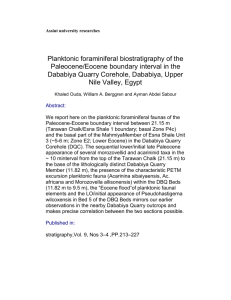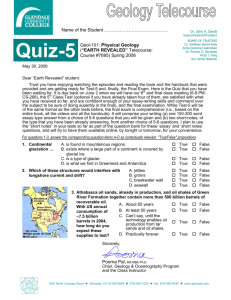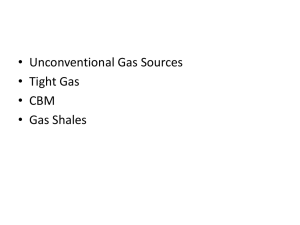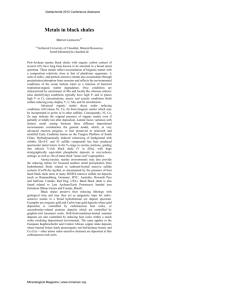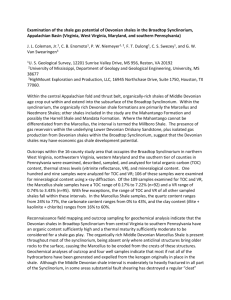Document 13876697
advertisement
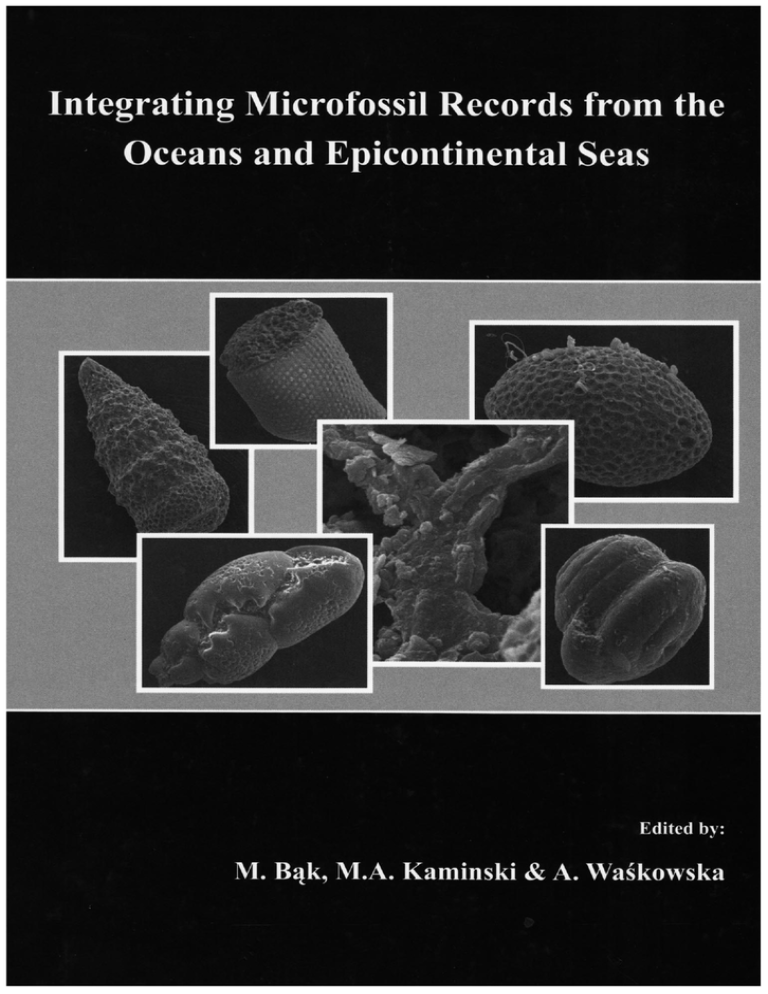
Integrating Microfossil Records from the Oceans and Epicontinental Seas 53 7 Deep-water agglutinated foraminifera in Paleogene hemipelagic sediments of the Magura Basin in the Sucha Beskidzka area – variegated shales of the Łabowa Shale Formation Marek CIESZKOWSKI1, Anna WAŚKOWSKA2, & Michael A. KAMINSKI3 1 Jagiellonian University, Institute of Geological Sciences, Oleandry 2a, 30-063 Kraków, Poland; marek.cieszkowski@uj.edu.pl, 2 AGH University of Science and Technology, Faculty of Geology, Geophysics and Environmental Protection, al. Mickiewicza 30, 30-059 Kraków, Poland; waskowsk@agh.edu.pl 3 Earth Sciences Department, King Fahd University of Petroleum and Minerals, Dhahran, 31261, Saudi Arab ia ABSTRACT Sedimentation of the variegated shales of the Łabowa Shale Formation in the Siary Zone of the Magura Basin commenced during the late Paleocene and lasted up to the middle Eocene. Quiet sedimentation of shales, mostly from a free fall suspension regime below the CCD, was favorable for the development of agglutinated foraminiferal communities. The Paleocene shales contain characteristic rich assemblages of the Rzehakina fissistomata Zone, followed by poor Recurvoides and Glomospira assemblages of the latest Paleocene and earliest Eocene connected with the LPTM crisis interval. These are followed by post-crisis Karrerulina assemblages, as well as assemblages of the Saccamminoides carpathicus Zone (Early Eocene) and the Reticulophragmium amplectens Zone (middle Eocene). Numerous very thin bentonite layers in the upper variegated shales subdivision of the Łabowa Shale Formation are found. The foraminiferal assemblages from these bentonite intercalations show low taxonomic diversity with numerous juvenile forms and increased numbers of Glomospira charoides (Jones & Parker). Key words: Magura Basin, Łabowa Shale Formation, hemipelagic sedimentation, Late Paleocene–middle Eocene, agglutinated foraminifera INTRODUCTION The Łabowa Shale Formation is found within the middle and northern facies-tectonic zones of the Magura Nappe (Bystrica, Rača and Siary zones) in the Northern Outer Carpathians in Poland, Slovakia, and the Czech Republic (Fig. 1). The name “Łabowa beds” was firstly used by Węcławik (1986) with reference to the Paleocene–Eocene variegated shales of the Magura Series – the sedimentary succession of the Magura Nappe. This division was previously described as the “variegated Eocene” (e.g., Kozikowski, 1953) or “variegated shales” (Książkiewicz, 1948, 1951, 1953, 1958, 1962, 1966a, b, 1974a, b; Bieda et al., 1967; Sikora & Żytko, 1959; Unrug, 1968, Węcławik, 1969; Sikora, 1970; Oszczypko, 1973; In: Bąk, M., Kaminski, M.A. & Waśkowska, A. (eds), 2011. Integrating Microfossil Records from the Oceans and Epicontinental Seas. Grzybowski Foundation Special Publication, 17, pp. 53–63. 54 M. Bąk, M.A. Kaminski & A. Wa śkowska (eds) Burtan, 1973a, b; Golonka & Wójcik, 1976, 1978; Cieszkowski, 1992a, b and Kender et al., 2005). In the Czech and Slovak republics the “variegated shales” have been included into the Beloveža Formation (Beloveža beds) as the lower part of this division (e.g., Pesl, 1963; Andrusov, 1965; Leško, & Samuel, 1968; Roth, 1967; Eliaš et al., 1990, Pivko, 2002). The Łabowa Shale Formation was named by Oszczypko (1991) in his paper presenting the new formal stratigraphy of the Paleogene sedimentary succession of the Bystrica Subunit (Zone) of the Magura Nappe. This lithostatigraphic division of the Magura Series consists of the Paleocene – Eocene variegated shales underlain by the Upper Cretaceous–Paleocene flysch deposits of the Ropianka Formation (Inoceramian beds) or Jaworzynka Formation (biotite facies of the Inoceramian beds), and overlain by the Lower and middle Eocene thin-bedded flysch of the Beloveža Formation. The author has chosen the type section of the discussed formation in Łabowa village in the Beskid Sądecki mountain range. There along the Uhryński Creek one of the best exposures of the Paleogene variegated shales of the Magura Nappe is located. The profile at Żeleźnikowski Stream in Żeleźnikowa village in the Beskid Sądecki has been proposed as the reference section. Others were chosen at Zbludza Stream flowing southward from the Beskid Wyspowy and Zasadne Stream flowing northeastward from the Gorce mountain range, both flowing into the Kamenica Gorczańska River in Kamienica village. Though Oszczypko (1991) focused on the sedimentary succesion of the Bystrica Subunit, in his paper he stated that the Łabowa Formation is widespread in the whole of the Magura Nappe with the only exception being the Krynica Subunit (Zone). Figure 1. The geological setting of the Tarnawa Dolna quarry profile. A – Localization on the West Polish Carpathians tectonic-sketch map. B – The geological map of the Sucha Beskidzka area (modified after Książkiewicz, 1974a) Integrating Microfossil Records from the Oceans and Epicontinental Seas 55 Figure 2. Lithostratigraphic log of the Siary Zone (Magura Nappe) in the Sucha Beskidzka area Following Oszczypko (1991), the name “Łabowa Shale Formation” has been used in later publications (e.g., Oszczypko, 1992a, b; Oszczypko et al., 1999, 2005; Cieszkowski et al., 1999; Waśkowska-Oliwa & Malata, 1999; Waśkowska-Oliwa, 2000; Cieszkowski & Waśkowska-Oliwa, 2001). Cieszkowski & Waśkowska-Oliwa (2001) first used the formal name of the discussed lithostratigraphic division to describe the variegated shales from the Siary Subunnit of the Magura Nappe in the Sucha Beskidzka area. They proposed to consider outcrops of the Łabowa Shale Formation exposed in Sucha Beskidzka along the Stryszawka Creek as a further type section. Cieszkowski & Waśkowska-Oliwa (2001) concentrated especially on two of the thick-bedded sandstone levels interbedding the variegated shales and proposed to divide them as a new formal division with the rank of lithostratigraphic members of the Łabowa Shale Formation. The lower level was named the Żurawnica Sandstone Member, and the upper the Skawce Sandstone Member (cf. also: Cieszkowski et al., 2006, Cieszkowski & Waśkowska, this volume). Lithological development of the Łabowa Shale Formation. In its type area, the Łabowa Shale Formation is represented by clayey, red and cherry-red, noncalcareous, massive shales with intercalations of gray-bluish shales, with very thin-bedded silt-mud couplets, occasionally with very thin sandstone turbidites showing Bouma’s Tcd subdivisions (Oszczypko, 1991). In the Sucha Beskidzka area a very similar development of shale complexes of this formation have been noticed, but here thick-bedded sandstone members occur (Fig. 2). In the lower part of the formation, below the Żurawnica Sandstone Member red clayey massive shales dominate. In the middle part between the discussed members and in the upper part above the Skawce Sandstone Member red shales are 56 M. Bąk, M.A. Kaminski & A. Wa śkowska (eds) Figure 3. Outcrops of the Łabowa Shale Member – upper part in the Stryszawka section. 1 – General view. 2 – variegated (red, green and gray) shales with sandy intercalations. 3 – Cherry shales with very thin-bedded sandstones. 4 – Zone with bentonite intercalation intercalated with a different frequency with thin layers of green shales and occasionally by thin- or very thin thin-bedded green quartz-glauconitic sandstones representing the turbidite Tcd subdivisions. Within the Łabowa Shale Formation occasional very thin intercalations of benthonites as well as manganiferous mineralizations have been recorded. In the surroundings of Sucha Beskidzka, this formation is underlain by the Ropianka Formation and overlain by the Beloveža Formation, but often directly by the Zembrzyce Shale Member (Submagura Shales) of the Maków Formation (Cieszkowski & Waśkowska-Oliwa, 2001; Cieszkowski et al., 2006). Sedimentation of the variegated shales of the Łabowa Shale Formation took place below the CCD, in quiet, hemipelagic conditions comparable to those of an abyssal plane. Occasional activity of low-density turbidite currents took place. Only in the northern part of the Magura Basin in the Siary Zone, an increasing flux of high-density turbidity currents formed two levels of thick-bedded sandstones-the Żurawnica and Skawce sandstone members-that formed a channel-lobe sedimentary system (Cieszkowski & Waśkowska, this volume). The upper variegated shales of Łabowa Formation Recently, outcrops of the Łabowa Formation in Sucha Beskidzka formed in the bed and banks of the Stryszawka River (Fig. 3). They are located in the central part of the Sucha Beskidzka, north of the railway station and in the eastern part between the hamlets Kotlinki and Głuszki. The second are Integrating Microfossil Records from the Oceans and Epicontinental Seas 57 especially well exposed. During last several years, lowering of the erosional base of the river caused removal of aluvial gravels filling the river bed and the deposits of the Magura Series were exposed. Below the bridge in Głuszki at a distance of 0,5 km downriver it is possible to observe variegated shales of the upper part of the Łabowa Formation, folded and cut by a sequence of meso-scale faults. Red clayey massive shales pass up the section into red intercalated by green. Within the massive red shales lamina 1– 5 mm thick of bentonites and manganese mineralisations occur. Manganese oxides occur in shales especially in places with intense tectonic fracture density. Traces of malachite have also been noticed. Occasional intercalations of thin- or very thin thin-bedded green quartz-glauconitic sandstones representing turbidite Tcd subdivisions are more frequent in the upper part of the section. In uppermost part of the formation, couplets of several thin-bedded sandstone layers intercalated by gray-green shales developed as a Hieroglyphic bed-like facies are observed. Upsection, the Łabowa Shale Formation passes into the Beloveža Formation, middle–late Eocene in age, represented by light gray, thin- and medium-bedded, fine grained calcareous sandstones with parallel and cross laminated Bouma (Tbcd and Tcd) sequences, intercalated by gray-bluish marly shales. Thin or medium bedded intercalations of soft, light-gray marls and occasional thin layers of calciturbidites also occur. In one place thick-bedded sandstones of the Skawce Sandstone Member arrive from below the red shales. The contact between the red shales and the sandstones is not normal, but tectonic. The sandstones formed a kind of horst delimited by a few faults. METHODS The Łabowa Shale Formation has been studied in detail by the authors during the field investigation carried out in the Sucha Beskidzka area in the last several years. The area was mapped and the sampling for different analyses including also foraminifera. The material for biostratigraphical analysis (in number of 30 samples) was taken from variegated shales from Skawce, Sucha Beskidzka PKP, Grygle, Żurawnica and Błądzonka sections. Usually a few samples were picked from each locality in different parts of the outcropping section of the Łabowa Shale Formation, documenting the lower, middle and upper levels of the variegated shales. Additionally, the upper shales were sampled in more detail, especially the part of the sections containing bentonite intercalations in the Stryszawka section (10 samples from section is described above). The mudstones or muddy siltstone samples (about 0,5 kg) were prepared using standard micropaleontological methods (maceration in Glauber’s salt solution, sieving over a 63 µm sieve, picking foraminiferal specimens from residue). RESULTS Foraminifera of the Łabowa Shale Formation from Sucha Beskidzka area The Paleocene–Eocene time interval in the Magura Basin is associated with the sedimentation of variegated shales of the Łabowa Shale Formation (Oszczypko, 1991). The origin of this type of sedimentation is first seen in the Siary Zone, in northern marginal part of the Magura Basin. Later this sedimentation steeply covered other parts of the basin floor. The quiet sedimentation, mostly from freefall suspension, was favorable for development of foraminiferal communities. Therefore, the Łabowa Shale Formation is known as a micropaleontologically well-documented lithostratigraphic subdivision (e.g., Bieda et al., 1967; Geroch et al., 1967; Jednorowska, 1966, 1968; Kender et al., 2005; Książkiewicz, 1974b; Jurkiewicz, 1967; Malata, 1981; Malata et al., 1996). Usually well-preserved, abundant specimens and taxonomically diversified assemblages are known from this deposits. Foraminiferal assemblages contain mainly agglutinated foraminifera, typical for deep water environments below the CCD (Cieszkowski & Waśkowska-Oliwa, 2001; Malata, 2000; Olszewska & Malata, 2006; Waśkowska-Oliwa, 2000), recognized as an autochtonous microfauna. Deposits of the Late Paleocene–middle Eocene time interval include a complete foraminiferal record. In the lower variegated shale subdivision below the Żurawnica Sandstone Member, this is registered by 58 M. Bąk, M.A. Kaminski & A. Wa śkowska (eds) Paleocene assemblages with Rzehakina fissistomata (Grzybowski) and Annectina grzybowskii (Jurkiewicz). Assemblages of the middle variegated shale division are diverse and in stratigraphic order contain assemblages with numerous Recurvoides, followed by Glomospira and Karrerulina, and finally assemblages with Saccamminoides carpathicus Geroch. Such a succession of assemblages is connected with uppermost Paleocene to Early Eocene time interval. The Late Paleocene Thermal Maximum (LPTM) had a distinct affect on the composition of the deep water foraminiferal communities (Kennett & Stott, 1991; Miller et al., 1987; Pak & Miller, 1992; Thomas, 1998; Thomas & Shackleton, 1996; Tjalsma & Lohman, 1983; Galeotti et al., 2004). Foraminiferal communities reacted to changes in the deep-water environment caused by the mass extinction of benthic foraminifera. As a consequence, 16 species disappeared in the Magura Basin (Olszewska & Malata, 2006), and post LPTM-crisis assemblages are undifferentiated and dominated by Glomospira charoides (Jones & Parker). This oportunistic assemblage gives way to a more varied assemblage with numerous Karrerulina conversa (Grzybowski) and Karrerulina coniformis (Grzybowski) indicating more favorable life conditions (Bąk, 2004). The assemblages with numerous Reticulophragmium amplectens (Grzybowski) and Reophax pilulifer Brady are characteristic for the sub division of variegated shales placed in section above the Skawce Sandstone Member and indicate the middle Eocene age of shaly sedimentation. Westward in the Myślenice area, a single Ammodiscus latus Grzybowski was found in this upper division of variegated shales. Foraminiferal record of the Łabowa Shale Formation (upper subdivision) in Stryszawka creekreference section The uppermost variegated shale subdivision of the Łabowa Formation is well exposed in the banks of Stryszwka creek in Stryszawa village. The foraminiferal assemblages from this locality are typical for the Reticulophragmium amplectens biozone (zones after Olszewska, 1997) and contain only agglutinated cosmopolitan deep-water forms. The index taxon is numerous and occurs together with Ammodiscus div. sp., Ammolagena clavata (Jones & Parker), Bathysiphon spp., Glomospira div. sp., Karrerulina conversa (Grzybowski), Recurvoides div. sp. and Thalmannammina subturbinata (Grzybowski), Reophax pilulifer Brady, and numerous Pseudonodosinella elongata (Grzybowski), Paratrochamminoides div. sp. (P. subcoronatus (Grzybowski)-common), Rhabdammina, Haplophragmoides walteri (Grzybowski), Placentammina placenta (Grzybowski), Haplophragmoides kirki Wickenden, Cribrostomoides subglobosus (Cushman), Subreophax pseudoscalaris (Samuel), Karrerulina coniformis (Grzybowski), and Eggerella propinqua (Brady). As additional components radiolaria and single fish teeth were found there. Rich and diversified assemblages developed in Magura Basin during slow deposition. The sedimentation rate is estimated to be on the order of 15-20m/mln years (Oszczypko & OszczypkoClowes, 2006). In the Łabowa Shale Formation (upper shale subdivision) numerous epifaunal species Ammolagena clavata (Jones & Parker) attached to foraminiferal tests were found. Specimens of Ammolagena clavata are observed with foraminifera belonging to epifaunal Rhabdammina, Ammodicus, and Paratochamminoides, as well as it is attaching to some infaunal tests e.g., Reticulophragmium, Reophax, Recurvoides and Karrerulina. Probably Ammolagena clavata settled on infaunal tests (dead foraminifera) exposed on the surface of sediment (Kaminski et al., 2009), during conditions of minimal delivery of sedimentary material depositing on the basin floor. The low sedimentation rate was favourable for the deposition of bentonites, and intercalations of thin bentonite layers are observed within the variegated shales of the Łabowa Formation. These are connected with volcanic activity that produced volcanic ash falling to the sea floor in Eocene times. The upper variegated shales sub division contains the most numerous bentonite layers. Deposition of bentonite in the deep water of basin is reflected by very low supply of clastic material, consequently pyroclastics were not diluted by terrigenous material. Reduced foraminiferal assemblages were Integrating Microfossil Records from the Oceans and Epicontinental Seas 59 Plate 1. Foraminifera from the Łabowa Shale Formation (upper subdivision) in the Stryszawka section. 1 – Ammodiscus cretaceus (Reuss). 2 – Glomospira gordialis (Jones & Parker). 3 – Glomospira glomerata (Grzybowski). 4 – Glomospira charoides (Jones & Parker). 5 – Reophax duplex Grybowski. 6 – Reophax pilulifer Brady. 7 – Pseudonodosinella elongata (Grzybowski). 8 – Paratrochamminoides heteromorphus (Grzybowski). 9 – Reticulophragmium amplectens (Grzybowski). 10 – Karrerulina coniformis (Grzybowski). 11 – Karrerulina conversa (Grzybowski). Scale bar – 100µm observed in samples taken from benthonite layers. Usually dwarfed foraminifera with low taxonomic diversity and numerous juvenile forms (especially many specimens of Reticulophragmium amplectens (Grzybowski)), with an increased number of Glomospira charoides (Jones & Parker) were observed. This type of assemblage is known as a crisis assemblage, reflecting local short-term environmental changes, and were observed in Lower Eocene bentonites of the Subsilesian Sedimentary Zone in the Outer Carpathians (Waśkowska, 2011). 60 M. Bąk, M.A. Kaminski & A. Wa śkowska (eds) In mudstone intercalations, a low diversity assemblage (represented by a few species only) is observed, with dominant Reticulophragmium amplectens (Grzybowski) and Reophax pilulifer Brady, occasionally rich Karrerulina conversa (Grzybowski). Generally the infaunal group dominates. Typical for this assemblage is the occurrence rather large-size specimens with coarse-grained tests and a lack of fragile foraminifera. This community reflects variable sedimentary conditions during the Łabowa Shale deposition and represents episodes with an increased supply of clastic material to the floor of the Magura Basin during the middle Eocene. Then, the barren samples with no microfauna correspond with intervals when the sea floor was not recolonized after a catastrophic higher energy turbidic flow. In the uppermost part of the Łabowa Formation the thin-bedded sandstone intercalations occur more frequently (Waśkowska-Oliwa, 2000). CONCLUSIONS In the Sucha Beskidzka area, the Łabowa Shale Formation is interbedded by two relatively thick sandy complexes. They subdivide the section of variegated shales to three levels: lower, middle and upper. The sedimentation of the Łabowa Shale Formation lasted from the late Paleocene (Rzehakina fissistomata zone – uppermost part) up to the middle Eocene (Reticulophragmium amplectens zone). The results of the global LPTM event are recorded in the middle variegated shales, though the sequence of Recurvoides, Glomospira, Karrerulina associations and assemblages are characteristic for Saccamminoides carpathicus zone. Low sedimentation rate during the deposition of the Łabowa Formation is reflected in sedimentary features of the sediments, especially in bentonites. It is likewise reflected in the very rich and taxonomically diversified foraminiferal assemblages and particularly numerous specimens of Ammolagena clavata Jones & Parker attached to the infaunal tests of other foraminifera. Detail sampling shows that environmental conditions during the Łabowa Shale Formation sedimentation were variable. Foraminiferal communities existing on the floor of the Magura Basin were subjected to numerous crises. Each episode (e.g., connected with the deposition of dilute pyroclastic material or a smalll amount of sandy material) modified the taxonomical structure of the assemblages. ACKNOWLEDGEMENTS This research has been financed by scientific projects of the AGH University of Science and Technology no 11.11.140.447 and the Jagiellonian University no K/ZDS/001678. REFERENCES Bąk, K. 2004. Deep-water agglutinated foraminiferal changes across the Cretaceous/Tertiary and Paleocene/Eocene transitions in the deep flysch environment; eastern Outer Carpathians (Bieszczady Mts, Poland). In: Bubik M. & Kaminski M.A. (eds), Proceedings of the Sixth International Workshop on Agglutinated Foraminifera. Grzybowski Foundation Special Publication, 8, 1–56. Bieda, F., Geroch, S., Koszarski, L., Ks iążkiewicz, M. & Żytko, K. 1963. Stratigraphie des Karpates Externes polonaises. Biuletyn Instytutu Geologicznego, 181, 5–174. Bieda, F., Jednorowska, A. & Książkiewicz, M. 1967. Stratigraphy of the Magura Series around Babia Góra. Biuletyn Instytytu Geologicznego, 211, 293–325. Burtan, J. 1973a. Szczegółowa Mapa Geologiczna Polski, 1:50 000, arkusz Wisła. Wydawnictwa Geologiczne, Warszawa. Burtan, J. 1973b. Objaśnienia do Szczegółowej Mapy Geologicznej Polski, 1:50 000, arkusz Wisła. Wydawnictwa Geologiczne, Warszawa [In Polish]. Cieszkowski, M. & Waśkowska, A. 2011 (this volume). The Żurawnica Sandstone and Skawce Sandstone members of the Łabowa Formation in the northern zone of the Magura Basin. In: Bąk, M., Kaminski, M.A. & Waśkowska, A. (eds), 2011. Integrating Microfossil Records from the Oceans and Epicontinental Seas. Grzybowski Foundation Special Publication, 17, pp. 43–50. Cieszkowski, M. & Waśkowska-Oliwa, A. 2001. Skawce Sandstone Member – a new formal lithostratigraphic subdivision of the Łabowa Shale Formation in the Siary Subunit of the Magura Nappe (Polish Outetr Carpathians). Bulletin of Polish Academy of Sciences, Earth Science, 49, 137–149. Integrating Microfossil Records from the Oceans and Epicontinental Seas 61 Cieszkowski, M. 1992a. Strefa Michalczowej – nowa jednostka strefy przedmagurskiej w Zachodnich Karpatach Fliszowych i jej geologiczne otoczenie. Geologia – Kwartalnuk AGH, 18, 1–125 [In Polish with English summary]. Cieszkowski, M. 1992b. Płaszczowina magurska i jej podłoże na północ od Kotliny Sądeckiej. Przegląd Geologiczny, 40, 410–417 [In Polish with English summary]. Cieszkowski, M. 2001. Fore-Magura Zone of the Outer Carpathians in Poland. Biuletyn Państwowego Instytutu Geologicznego, 396, 32–33. Cieszkowski, M., Golonka, J., Waśkowska-Oliwa, A. & Chrustek, M. 2006. Geological structure of the Sucha Beskidzka –Świnna Poręba region (Polish Flysch Carpathians). Kwartalnik AGH Geologia, 23, 155–201 [In Polish]. Cieszkowski, M., Oszczypko, N., Pescatore, T.S., Senatore, M.R., Ślączka, A. & Valente, A. 1995. Megatorb iditi calcareo-marnose nelle succesioni flyscioidi dell Appennino Meridionale (Cilento, Italia) e dei Carpazi Settentrionali (Polonia). Bolletino della Società Geologica Italiana, 114, 67–88. Cieszkowski, M., Schnabel, W. & Waśkowska-Oliwa, A. 1999. Development and stratigraphy of the Paleocene– Early Eocene thick bedded turbid ites in the north-western zone of the Magura Nappe, Outer Carpathians, Poland. Geologica Carpathica, 50, 20–21. Galeotti, S., Kaminski, M.A., Coccioni, R. & Speijer, R. 2004. High resolution deep-water agglutinated and calcareous hyaline foraminiferal record across the Paleocene/Eocene transition in the Contessa Road section (central Italy). In: Bub ik, M., & Kaminski, M.A., (eds), Proceedings of the Sixth International Workshop on Agglutinated Foraminifera. Grzybowski Foundation Special Publication, 8, pp. 83–103. Geroch, S., Jednorowska, A., Książkiewicz, M. & Liszkowa, J. 1967. Startigraphy based upon microfauna in the Western Polish Carpathians. Biuletyn Instytutu Geologicznego, 211, 185–182. Golonka, J. & Wójcik, A. 1976. Szczegółowa Mapa Geologiczna Polski, 1:50.000, arkusz Jeleśnia. Wydawnictwa Geologiczne, Warszawa [In Polish]. Golonka, J. & Wójcik, A. 1978. Objaśnienia do Szczegółowej Mapa Geologicznej Polski, 1:50.000, arkusz Jeleśnia. Wydawnictwa Geologiczne, Warszawa, 40 pp [In Polish with English summary]. Golonka, J., Gahagan, L., Krobicki, M., Marko, F., Oszczypko, N. & Ślączka, A. 2005. Plate tectonic evolution and paleogeography of the circum-Carpathian region. In: Picha, F. & Golonka, J. (eds), The Carpathians and their foreland: Geology and hydrocarbon resources. American Association of Petroleum Geologists, Memoir 84, 1–60. Golonka, J., Borysławski, A., Paul, Z. & Ryłko, W. 1981. Mapa Geologiczna Polski 1:200.000, arkusz BielskoBiała. Wydawnictwa Geologiczne, Warszawa [In Polish]. Golonka, J., Oszczypko, N. & Ślączka, A. 2000. Late Carboniferous–Neogene geodynamic evolution of the CircumCarpathian region and adjacent areas. Annales Societatis Geologorum Poloniae, 70, 107–136. Grzybowski, J. 1921. Ciężkowice Sandstones. Kosmos, 46, 222–226 [In Polish]. Jednorowska, A. 1966. Zespoły małych otwornic w warstwach jednostki magurskiej rejonu Babiej Góry i ich znaczenie stratygraficzne. Przewodnik XXXIX Zjazdu Polskiego Towarzystwa Geologicznego – Babia Góra, Wydawnictwa Geologiczne, 71–90 [In Polish]. Jednorowska, A. 1968. Zespoły otwornicowe w zewnętrznych strefach jednostki magurskiej Karpat i ich znaczenie stratygraficzne. Prace Geologiczne Polskiej Akademii Nauk Oddział Kraków, Komisja Nauk Geologicznych, 50, 1–89 [In Polish with Russian and French summary]. Kaminski, M.A., Henderson, A.S., Cetean, C.G. & Waśkowska, A. 2009. The Ammolagenidae a new family of Foraminifera, and the evolution if multichambered tests. Micropaleontology, 55, 287–494. Kender, S., Kaminski, M.A. & Cieszkowski, M. 2005. Foraminifera from the Eocene variegated shales near Barwinek (Magura Unit, Outer Carpathians), the type locality of Noth (1912) revisited. Annales Societatis Geologorum Poloniae, 75, 249–271. Kenett, J.P. & Stott, L.D. 1991. Abrupt deep-sea warming, paleoceanographic changes and benthic extinctions at hte end of the Palaeocene. Nature, 353, 225–229. Książkiewicz, M. 1962. Cretaceous and Early Tertiary in the Polish External Carpathians [In Polish, English summary]. In: Książkiewicz, M. (Ed.), Geological Atlas of Poland 1:600.000, Stratigraphical and facial problems, 13. Instytut Geologiczny, Warszawa. Książkiewicz, M. 1948. Stratygraphy of the Magura series north of the Babia Góra, Western Carpathians Biuletyn Instytutu Geologicznego, 48, 1–33 [In Polish with English summary]. Książkiewicz, M. 1958. Stratygrafia serii magurskiej w Beskidzie Średnim. Biuletyn Instytutu Geologicznego, 135. 43–82 [In Polish, with English summary]. Książkiewicz, M. 1966. Geologia regionu babiogórskiego. Przewodnik XXXIX Zjazdu Polskiego Towarzystwa Geologicznego – Babia Góra, Wydawnictwa Geologiczne, 5–58 [In Polish]. 62 M. Bąk, M.A. Kaminski & A. Wa śkowska (eds) Książkiewicz, M. 1966. Palinspastic reconstuction of the Carpathian Arc before Neogene tectogenesis. Rocznik Polskiego Towarzystwa Geologicznego, 39, 3–21. Książkiewicz, M. 1974a. Szczegółowa Mapa Geologiczna Polski, 1:50 000, arkusz Sucha Beskidzka. Wydawnictwa Geologiczne, Warszawa [In Polish]. Książkiewicz, M. 1974b. Objaśnienia do Szczegółowej Mapy Geologicznej Polski, 1:50 000, arkusz Sucha Beskidzka. Wydawnictwa Geologiczne, 83 pp [In Polish]. Leško, B. & Samuel, O. 1968. Geológia východoslovenského flyšu. Vyd. Slov. Akad. Vied, Bratislava, 245 pp. Malata, E. 2000. Foraminiferal assemblages of the Magura Nappe (Polish Outer Carpathians) and their paleobathymetrical imp lications. Slovak Geological Magazine, 6, 172–174. Malata, E., Malata, T. & Oszczypko, N. 1995. Litho- and biostratigraphy of the Magura Nappe in the Eastern part of the Beskid Wyspowy Range (Polish Western Carpathians). Annales Societatis Geologorum Poloniae, 66, 269– 284. Malata, E. 1981. The stratigraphy of the Magura Nappe in the Western part of the Beskid Wysoki Mts., Poland based on microfauna. Biuletyn Instytutu Geologicznego, 331, 103–116 [In Polish with English summary]. Miller, K.G., Janesek, T.R., Katz, M.E. & Keil, D.J. 1987. Abysal circulation and benthic foraminiferal changes near Paleocene/Eocene boundary. Paleaoceanography, 2, 741–761. Nowak, J. 1921. Sur la stratigraphie du district de Magura aux environs de Rabka. Kosmos, 46, 227–241 [In Polish]. Olszewska, B. & Malata, E. 2006. Analiza paleośrodowiskowa i paleobatymetryczna zespołów mikroskamieniałości polskich Karpat zewnętrznych. In: Oszczypko N. et al. (eds), Palaeotectionic evolution of the Outer Carpathian and Pieniny Klippen Belt basins. Instytut Nauk Geologicznych, Uniwersytet Jagielloński, pp. 61–84 [In Polish with English abstract]. Olszewska, B. 1997. Foraminiferal biostratigraphy of the Polish Outer Carpathians, A record of basin geohistory. Annales Socetatis Geologorum Poloniae, 67, 325–337. Oszczypko, N. & Oszczypko-Clowes, M. 2006. Evo lution of the Magura Basin. In: Oszczypko N. et al. (eds), Palaeotectionic evolution of the Outer Carpathian and Pieniny Klippen Belt basins. Instytut Nauk Geologicznych UJ, pp. 133–166 [In Polish with English abstract]. Oszczypko, N. 1973. Budowa geologiczna Kotliny Sądeckiej. Biuletyn Instytutu Geologicznego, 271, 105–190 [In Polish with English summary]. Oszczypko, N. 1991. Stratigraphy of the Palaeogene deposits of the Bystrica subunit (Magura Nappe, Polish Outer Carpathians). Bulletin of Polish Academy of Sciences, Earth Sciences, 39, 415–431. Oszczypko, N. 1992a. Zarys stratygrafii p łaszczowiny magurskiej. In: Zuchiewicz W. & Oszczypko N. (eds), Przewodnik LXIII Zjazdu Polskiego Towarzystwa Geologicznego, Koninki 17–19 września, Wydawnictwo ING PAN, Kraków, pp. 11–20 [In Polish]. Oszczypko, N. 1992b. Late Cretaceous through Paleogene evolution of the Magura Basin. Geologica Carpathica, 46, 33–338. Oszczypko, N., Malata, E., Bąk, K., Kędzierski, M., & Oszczypko-Clowes, M. 2005. Lithostratigraphy and biostratigraphy of the Upper Alb ian-Lower/Middle Eocene flysch deposits in the Bystrica and Raca subunits of the Magura Nappe; Western Flysch Carpathians (Beskid Wyspowy and Gorce Ranges, Poland). Annales Societatis Geologorum Poloniae, 75, 27–69. Oszczypko, N., Malata, E. & Oszczypko-Clowes, M. 1999. Revised position and age of the Eocene deposits of the Magura Nappe of the northern slope of the Gorce Range, Polish Outer Carpathians (Bystrica Subunit, Magura Nappe, Polish Outer Carpathians). Slovak Geological Magazine, 5, 235–254. Pak, D.K. & Miller, K.G. 1992. Paleocene to Eocene benthic foraminiferal isotopes and assemblages: implications for deep-water circulation. Paleoceanography, 7, 405–422. Pesl, V. 1964. Vnitřní zóna račanské jednostky na východním Slovensku. Zpravy, Geologický Výzkum, v roce 1963, 2, Vyd. Geologický Ústav D. Štúra, Bratislava, pp. 127–129. Pickering, K., Stow, D., Watson, R. & Hiscott, R. 1986. Deep water fac ies, processes and models: a reveew and classification for modern and ancient sediments. Earth Sciences Reviews, 23, 75–174. Pivko, D. 2002. Geology of Pilsko Mountain and surroundings (Flysch belt of northern Orava). Acta Geologica Universitatis Comenianae, 57, 67–94. Sikora, W. & Żytko, K. 1959. Geology of the Beskid Wysoki Mts southern of Żywiec. Biuletyn Instytutu Geologicznego, 141, 61–204 [In Polish with English summary]. Skoczylas-Ciszewska, K. 1960. Budowa geologiczna strefy żegocińskiej. Acta Geologica Polonica, 10, 485–591 [In Polish with English summary]. Świdziński, H. 1947. S łownik stratygraficzny północnych Karpat fliszowych. Biuletyn Państwowego Instytutu Geologicznego, 37, 1–124 [In Polish]. Integrating Microfossil Records from the Oceans and Epicontinental Seas 63 Thomas, E. & Shackleton, N.J. 1996. The Paleocene-Eocene benthic foraminiferal extiction and stable anomalies. In: Knox, R.W. et al. (eds), Correlation of the Early Paleogene in Northwest Europe. Geological Society of America, Special Publications, 101, 401–411. Thomas, E. 1998. The biogeography of the Late Paleocene benthic foraminiferal extinction, In: Abury M.P., Lucas, S.G. & Berggren, W.A. (eds), Late Paleocene–Early Eocene biotic and climatic events in the marinae and terrestial records. Columbia University Press, New York, pp. 214–243. Tjalsma, R.C. & Lohman, G.P. 1983. Paleocene–Eocene bathyal and abyssal benthic foraminifera from the Atlantic Ocean. Micropaleontology Special Publication, 4, 1–90. Unrug, R. 1969. Przewodnik geologiczny po zachodnich Karpatach fliszowych. Wydawnictwa Geologiczne, Warszawa, 242 pp. Waśkowska-Oliwa, A. 2000. Biostratigraphic and paleoecologic interpretation of the agglutinated foraminifera assemblages of the Paleocene–Middle Eocene deposits of the Magura Nappe in the area of Sucha Beskidzka (Outer Carpathians). Przegląd Geologiczny, 48, 331–336. Waśkowska, A. 2011. Response of Early Eocene deep-water benthic foraminifera to volcanic ash falls in the Polish Outer Carpathians: Palaeocological implications. Palaeogeography, Palaeoclimatology, Palaeoecology, 305, 50–64. Waśkowska-Oliwa, A. & Malata, E. 1999. Paleoecological interpretation of small foraminiferal assemblages from the Paleocene-Middle Eocene deposits of the Magura Nappe in the area of Sucha Beskidzka. Geologica Carpathica, 50, 81–83.
